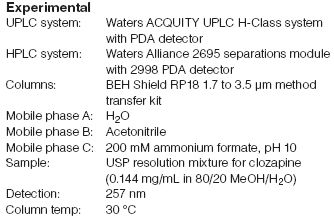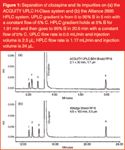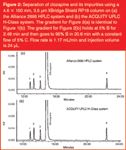Method Transfer Between HPLC and UPLC using ACQUITY UPLC H-Class and Method Transfer Kits
LCGC Asia Pacific
Waters Application Note
Kenneth J. Fountain, Hillary Hewitson and Damian Morrison, Waters Corporation, Milford, Massachusetts, USA.
Introduction
Transferring LC methods between instruments and/or laboratory sites is a common practice that allows analytical scientists to maximize equipment usage. Although common, method transfer can be a difficult task. Differences in the properties of the LC system and/or the ratio of the column volume to the system volume can produce gradient profiles that are inconsistent between the original method and the transferred method. The separation power and selectivity of the column must also remain constant when transferring from one LC to another, or when changing particle size. Complexity is added when methods are transferred between different technology platforms such as HPLC and UPLC.
In this application, a method for clozapine and four impurities is transferred from UPLC to HPLC using the ACQUITY UPLC H-Class system. Selectivity of the separation is preserved by using columns with the same stationary phase that differ only in particle size. A new columns calculator is used to maintain the gradient profile regardless of the instrument used for the separation. The resulting separations demonstrate the ability of the ACQUITY UPLC H-Class and column chemistries to facilitate methods transfer for any HPLC or UPLC separation.

Gradient, flow rate and injection volumes are specified in the figure captions. Calculations to preserve the gradient profile were performed with the new ACQUITY UPLC columns calculator.
Results and Discussion
Figure 1(a) shows the separation of the clozapine sample on a 2.1 × 50 mm, 1.7 μm BEH Shield RP18 column at high pH. All impurities were sufficiently resolved from the main active ingredient. This method was then transferred to an HPLC system using a column with identical resolving power and selectivity [Figure 1(b)]. The system dwell volumes were measured and input into the ACQUITY UPLC columns calculator to maintain the same gradient profile. Note that the selectivity between the two separations is identical and the relative retention times of each impurity to clozapine is maintained (Table 1).

Figure 1
The separation shown in Figure 1(b) was then transferred from the HPLC system back to the ACQUITY UPLC H-Class system to demonstrate the ability of the latter instrument to run both HPLC and UPLC separations. The resulting separation is shown in Figure 2(b). The gradient profile was maintained by accounting for the gradient delay volume of the HPLC and UPLC systems. Again, Table 1 shows that there is no difference in the relative retention times of all clozapine impurities, regardless of the system or column used.

Figure 2
Conclusions
The combination of the ACQUITY UPLC H-Class system and column method transfer kits facilitates the transfer of LC methods between HPLC and UPLC platforms. This allows methods to be easily transferred between systems, laboratories and sites across the world without compromising separation performance.

Table 1: Relative retention times of impurities to clozapine for HPLC and UPLC separations.
©2010 Waters Corporation. Waters, The Science of What's Possible, ACQUITY UPLC, XBridge and Alliance are trademarks of Waters Corporation.
Waters Corporation
34 Maple Street, Milford, Massachusetts 01757
tel. +1 508 478 2000, fax +1 508 478 1990
Website: www.waters.com

Accelerating Monoclonal Antibody Quality Control: The Role of LC–MS in Upstream Bioprocessing
This study highlights the promising potential of LC–MS as a powerful tool for mAb quality control within the context of upstream processing.
Using GC-MS to Measure Improvement Efforts to TNT-Contaminated Soil
April 29th 2025Researchers developing a plant microbial consortium that can repair in-situ high concentration TNT (1434 mg/kg) contaminated soil, as well as overcome the limitations of previous studies that only focused on simulated pollution, used untargeted metabolone gas chromatography-mass spectrometry (GC-MS) to measure their success.
Prioritizing Non-Target Screening in LC–HRMS Environmental Sample Analysis
April 28th 2025When analyzing samples using liquid chromatography–high-resolution mass spectrometry, there are various ways the processes can be improved. Researchers created new methods for prioritizing these strategies.
Potential Obstacles in Chromatographic Analyses Distinguishing Marijuana from Hemp
April 28th 2025LCGC International's April series for National Cannabis Awareness Month concludes with a discussion with Walter B. Wilson from the National Institute of Standard and Technology’s (NIST’s) Chemical Sciences Division regarding recent research his team conducted investigating chromatographic interferences that can potentially inflate the levels of Δ9-THC in Cannabis sativa plant samples, and possible solutions to avoid this problem.

.png&w=3840&q=75)

.png&w=3840&q=75)



.png&w=3840&q=75)



.png&w=3840&q=75)














